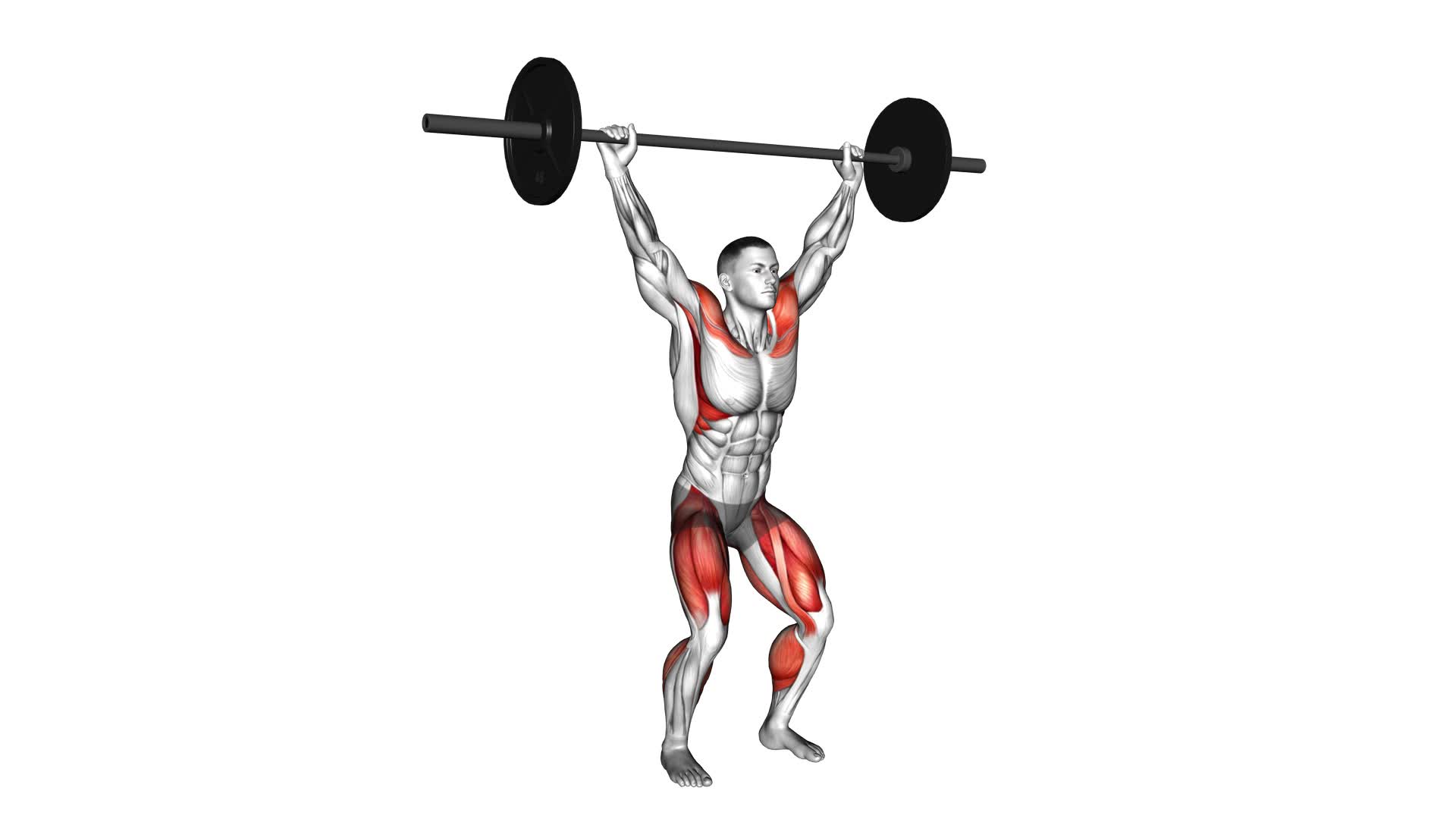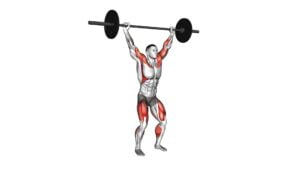Barbell Snatch Balance – Video Exercise Guide & Tips

Looking to improve your barbell snatch balance technique?
Watch This Exercise Video
This video exercise guide and tips will help you do just that.
Learn the proper form, avoid common mistakes, and discover variations and progressions to challenge yourself.
Incorporating barbell snatch balance into your workout routine can enhance your overall strength and stability.
Let's dive in and take your snatch balance to the next level.
Key Takeaways
- Barbell Snatch Balance improves overall stability, coordination, and balance.
- It strengthens core muscles and increases power and explosiveness.
- Proper technique includes starting with a wider snatch grip and using the legs and hips to generate power.
- Common mistakes to avoid are failing to fully extend hips and knees, allowing the barbell to drift too far in front of the body, and using excessive arm strength.
Barbell Snatch Balance Benefits
What are the benefits of performing the barbell snatch balance exercise?
Incorporating barbell snatch balance into your routine can provide numerous benefits. One of the main advantages is that it helps to improve your overall stability and coordination. By performing this exercise, you're forced to stabilize the barbell overhead while simultaneously squatting into a deep position. This not only strengthens your core muscles but also enhances your balance and control.
Another benefit of incorporating barbell snatch balance into your routine is that it can help to increase your power and explosiveness. This exercise requires a quick and explosive movement to drive the barbell overhead. By repeatedly performing this movement, you're training your muscles to generate more power and force, which can be beneficial for various athletic activities and sports.
Furthermore, the barbell snatch balance exercise can also be modified to suit your specific needs and goals. There are various variations of this exercise, such as the snatch balance with pause or the snatch balance from blocks, which can target different muscles and challenge your body in unique ways.
Proper Barbell Snatch Balance Technique
To properly perform the barbell snatch balance exercise, you need to focus on maintaining proper form and technique. Here are some key cues to keep in mind:
- Start with the barbell on your back, using a snatch grip that's wider than shoulder-width apart.
- Begin the movement by bending your knees and hips, initiating a quick and explosive upward drive.
- As the barbell rises, quickly drop under it and catch it in an overhead squat position.
- Use your arms to punch the barbell up and lock it out overhead, while keeping your core tight and your chest up.
These cues will help you execute the barbell snatch balance with precision and efficiency.
However, there are some common misconceptions about this exercise that you should be aware of. Some people mistakenly believe that the snatch balance should be performed with heavy weights, but it's actually more effective when practiced with lighter loads to focus on speed and technique.
In the next section, we'll discuss the common mistakes to avoid when performing the barbell snatch balance, so you can get the most out of this exercise and minimize the risk of injury.
Common Mistakes to Avoid
To maximize the effectiveness of the barbell snatch balance exercise and prevent injury, it's crucial to be aware of the common mistakes to avoid. By understanding these common errors in barbell snatch balance form, you can troubleshoot your technique and ensure that you're performing the exercise correctly.
One of the most common mistakes is failing to fully extend your hips and knees during the upward phase of the movement. This can lead to a lack of power and limit the amount of weight you're able to lift. To correct this, focus on explosively extending your hips and knees, driving the barbell overhead with speed and force.
Another mistake to avoid is allowing the barbell to drift too far in front of your body during the catch phase. This can cause you to lose balance and put unnecessary strain on your shoulders and wrists. To troubleshoot this issue, ensure that you're actively pulling yourself under the barbell and catching it directly overhead, with your wrists stacked above your shoulders.
Lastly, avoid using excessive arm strength to lift the barbell overhead. This can lead to inefficient movement patterns and increase the risk of injury. Instead, focus on using the power generated from your legs and hips to drive the barbell upward.
Variations and Progressions
To continue the discussion from the previous subtopic, let's explore some variations and progressions you can incorporate into your barbell snatch balance routine. These variations and progressions will help you improve your technique, increase your strength, and enhance your overall performance.
- Snatch balance regressions: If you're just starting out or struggling with the snatch balance, it's important to regress the movement and focus on building a solid foundation. Start by performing the snatch balance from a higher starting position, such as a power position or a hang position. This will allow you to work on your footwork, speed under the bar, and receiving position without the added complexity of a full snatch.
- Snatch balance mobility drills: Mobility plays a crucial role in executing the snatch balance correctly. Incorporating mobility drills into your warm-up routine will help you improve your flexibility and range of motion, allowing for a smoother and more efficient movement. Some effective snatch balance mobility drills include overhead squats, snatch grip presses, and shoulder dislocations.
- Overhead squats with snatch grip: This exercise is a great progression from the snatch balance as it further challenges your stability, mobility, and strength in the overhead position. By performing overhead squats with a snatch grip, you'll strengthen your upper back, shoulders, and core while also improving your snatch balance technique.
- Tempo snatch balances: Adding a tempo to your snatch balance can help you develop control, stability, and precision in the movement. Start by performing the snatch balance with a slow and controlled descent, pausing for a few seconds in the bottom position before exploding back up. This won't only enhance your positional awareness but also build strength and stability in the receiving position.
Incorporating these variations and progressions into your barbell snatch balance routine won't only keep your training interesting but also help you progress towards your goals more effectively. Remember to focus on good technique, listen to your body, and gradually increase the difficulty level as you improve.
Tips for Incorporating Barbell Snatch Balance Into Your Workout Routine
When incorporating barbell snatch balance into your workout routine, it's important to focus on proper form and technique. This exercise can be challenging, but with the right modifications and approach, it can be a beneficial addition to your weightlifting routine.
For beginners, it's recommended to start with an empty barbell or a light weight to practice the movement and develop the necessary strength and stability. As you become more comfortable, you can gradually increase the weight.
To ensure proper form, keep your feet shoulder-width apart and your toes pointed slightly outward. Start by lowering into a quarter squat, then explosively extend your hips, knees, and ankles while simultaneously pressing the bar overhead. As you catch the bar in the overhead position, make sure to stabilize your body and maintain a strong, upright posture.
If you find it difficult to maintain balance or struggle with the movement, try using a PVC pipe or resistance band to practice the snatch balance. These modifications can help you improve your form and build the necessary strength before progressing to heavier weights.
Remember to always listen to your body and work within your abilities. With consistent practice and proper form, barbell snatch balance can be a valuable exercise in your weightlifting routine.
Frequently Asked Questions
How Much Weight Should I Start With When Doing Barbell Snatch Balance?
When starting the barbell snatch balance, it's important to choose a weight that challenges you, but still allows for proper form and technique. The ideal starting weight will vary depending on your individual strength and experience level. As you progress, gradually increase the weight to continue challenging yourself.
The snatch balance exercise offers numerous benefits, including improved stability, flexibility, and explosiveness. It's a great way to enhance your overall athletic performance.
Can Barbell Snatch Balance Help Improve My Explosiveness in Other Exercises?
To improve explosiveness in other exercises, the barbell snatch balance can be a beneficial addition to your training routine. This exercise targets your lower body and core, helping to build strength and power.
By performing snatch balances regularly, you can enhance your ability to generate force quickly and explosively, which can translate to improved performance in movements like jumps, sprints, and Olympic lifts.
Incorporating snatch balances into your training can help you become more explosive and powerful overall.
Are There Any Specific Warm-Up Exercises I Should Do Before Attempting Barbell Snatch Balance?
Before attempting the barbell snatch balance, it's important to warm up properly to prevent injury and optimize performance.
Incorporate specific warm-up exercises like shoulder circles, hip mobility drills, and dynamic stretches. These exercises will help activate the muscles used in the snatch balance and improve your range of motion.
Can Barbell Snatch Balance Be Used as a Standalone Exercise or Should It Be Incorporated Into a Larger Training Program?
Barbell snatch balance can be used as a standalone exercise or incorporated into a larger training program.
As a standalone exercise, it offers benefits such as improving coordination, stability, and explosiveness.
It can also be used as part of a training program to enhance overall strength and power.
Whether you choose to do it alone or as part of a larger program, barbell snatch balance is a practical and effective exercise for athletes looking to improve their performance.
What Are Some Alternative Exercises That Can Be Done if I Don't Have Access to a Barbell for Snatch Balance?
If you don't have access to a barbell for snatch balance, there are alternative exercises you can do.
One option is to use dumbbells or kettlebells to perform snatch balance.
Another alternative is to use a resistance band to simulate the movement.
These exercises can help improve your stability, mobility, and explosive power, just like snatch balance with a barbell.
They're also great for overall strength training and enhancing your weightlifting performance.
Conclusion
Incorporating barbell snatch balance into your workout routine can provide numerous benefits, such as improving strength, stability, and coordination. By following proper technique and avoiding common mistakes, you can maximize the effectiveness of this exercise.
Additionally, variations and progressions can help you challenge yourself and continue to progress. Remember to consult with a fitness professional if you're unsure about the proper form or need assistance in modifying the exercise to suit your individual needs.

Author
Years ago, the spark of my life’s passion ignited in my mind the moment I stepped into the local gym for the first time. The inaugural bead of perspiration, the initial endeavor, the very first surge of endorphins, and a sense of pride that washed over me post-workout marked the beginning of my deep-seated interest in strength sports, fitness, and sports nutrition. This very curiosity blossomed rapidly into a profound fascination, propelling me to earn a Master’s degree in Physical Education from the Academy of Physical Education in Krakow, followed by a Sports Manager diploma from the Jagiellonian University. My journey of growth led me to gain more specialized qualifications, such as being a certified personal trainer with a focus on sports dietetics, a lifeguard, and an instructor for wellness and corrective gymnastics. Theoretical knowledge paired seamlessly with practical experience, reinforcing my belief that the transformation of individuals under my guidance was also a reflection of my personal growth. This belief holds true even today. Each day, I strive to push the boundaries and explore new realms. These realms gently elevate me to greater heights. The unique combination of passion for my field and the continuous quest for growth fuels my drive to break new ground.







